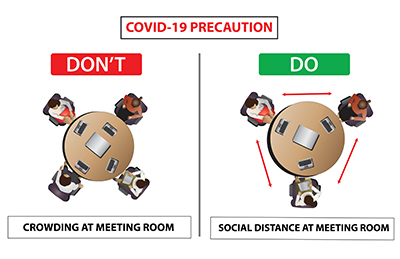Businesses are beginning to reopen, and I’m sure many folks are excited to get back into the swing of things. Working remotely is part of our DNA at Articulate, so our employees were better prepared than most for the shelter-in-place orders prompted by the COVID-19 pandemic. But even we struggled to find a new normal with partners, kids, roommates, and other family members who were also suddenly at home all the time.
Even though we’re all performing nearly impossible juggling acts at home, a survey my company recently conducted found that a majority of workers aren’t so sure that returning to the workplace will be smooth sailing either. Our survey revealed that:
- 2 out of 3 Americans (66%) are feeling anxious about returning to work.
- 59% of those who are anxious say their leading concern is the potential inability to maintain social distance with coworkers and customers.
- Sharing a bathroom (40%) and displeasure with wearing a facial mask (38%) were additional sources of discomfort.
Our survey, which we conducted in late May with 1,100 U.S. employees, also found that only 33% of those working from home during COVID-19 said their employer has shared a plan and provided training for returning to the workplace safely.
As a company president, I have to wonder: Why are only 33% of employees receiving training to help them stay safe at work during a pandemic? If we don’t boost that number, we’re all in trouble, given the amount of community spread we’re seeing countrywide.
Here are four tips for executives and HR managers who need help building an effective training plan for getting employees safely back to the workplace:
1. Make Your Content Digestible
Many employers make the mistake of creating super dense, text-heavy training that puts employees to sleep. Work with your team to break training into smaller chunks of information.
For example, you might divide your course into four key lessons: sanitation, in-office work schedules, conference room etiquette, and kitchen protocols. In each lesson, include a variety of content types so your employees don’t have to wade through a bunch of text. Use bullet points, callout statements, and media like video, images, and voice notes to break up information.
2. Create Interactive and Enjoyable Training
Training should never be passive, even when it’s online. Make your content interactive to boost knowledge retention and engagement. Your online training authoring tool should let you create interactive content easily.
You might create a labeled graphic of your kitchen area, with clickable markers that display additional information on how to safely use kitchen amenities. You could use a sorting activity that lets employees sort different practices, like hand-washing, handshaking, and mask-wearing, into “safe” and “unsafe” categories.
Or try offering an interactive scenario that lets employees choose which health-conscious actions they should take in a situation they’re likely to encounter in the workplace. Then, quiz your employees to confirm they’ve retained what they’ve learned and can apply it when they return.
3. Adjust Your Training to Fit Employees’ Current Needs
Many of us might have expected employees to be excited to go back to the workplace. But as both our survey and others have noted, people are super sensitive about staying healthy right now.
Taking a little extra time to understand your employees and their needs will help you formulate an effective training plan—and show your employees you care. Try sending out a quick online survey to learn about your employees’ anxieties. Then, work backward to address those issues in your training.
4. Make Your Training Rewarding
If your employees hear the word “training” and start to do an about-face, you’re not alone. Training has a bad rap in many companies because it’s often kludgy, ugly, buggy, and tedious.
So, in addition to making your training interactive, make sure it’s beautiful (which isn’t hard if you’ve got a good online training system). Your training should also generate a certificate that celebrates employees’ course completion.
Some companies offer an incentive—such as a gift card, entry into a giveaway, or a shortened workday—to encourage engagement. You might even reward employees who earn top marks on their quizzes with something special.
Whatever you do, be sure to prepare every employee to reenter the workplace and engage safely with colleagues, the physical workspace, and customers. And, don’t neglect their anxiety. COVID-19 has taken a toll on all of us, and you’ll do your employees a service if you build safety training that addresses both their physical and their mental health.
Keep in mind that the most important thing you can do is make sure your employees feel (and are) supported and prepared to stay healthy at work.
Lucy Suros is the president of Articulate, the company that is changing the way the world learns. She runs every aspect of Articulate, a SaaS business with two product lines, Articulate 360, and Rise.com, an all-in-one training system. Lucy also regularly writes and speaks on the topic of virtual training and remote work, sharing much of what she has learned from leading Articulate – one of the first and largest fully remote companies in America.
The post 4 Ways to Improve Your Return-to-Work Training Plan appeared first on HR Daily Advisor.
